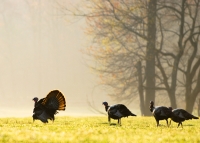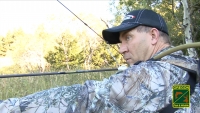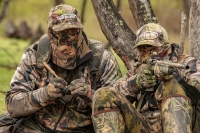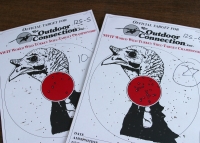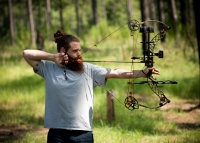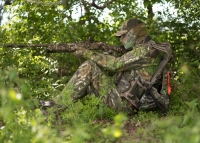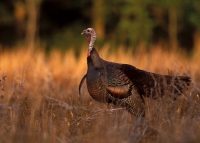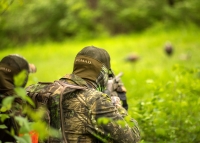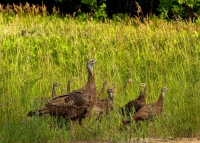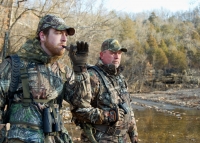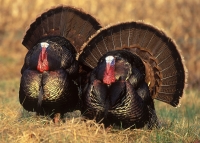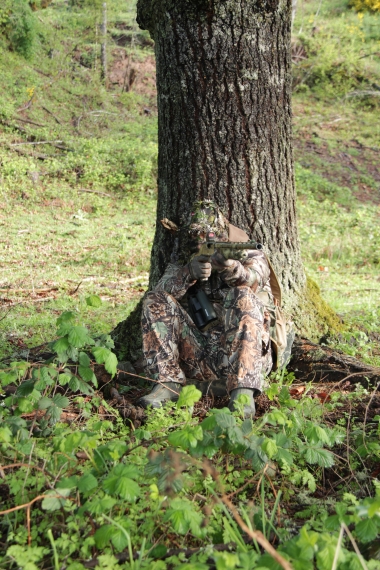
Hunting turkey with a bow
Bow vs. shotgun
There are fundamental differences between turkey hunting with a bow and a shotgun, including effective range, shot placement and set up.
Effective shooting distance
Your effective shooting distance (how far you can be from a turkey and likely kill it with a single shot) will vary with the level of your shooting skills and the type of equipment you’re using.
A good rule of thumb for shotgun shooters is 40 yards. Anything further than that and there’s a good chance you might not hit the head and neck with enough pellets to kill the bird.
Any closer than 20 yards and your pellet pattern may not have time to open up enough for maximum effectiveness.
Bow hunters, on the other hand, will often wait until a bird has come to within 20 yard before taking a shot.
Lethal shot placement
Shotgun hunters should take turkeys with a head and neck shot for a quick, clean kill. Shot shooters have a better chance at a lethal head shot than do bowhunters because shotgun pellets spread into a relatively wide pattern, and it takes just a handful of pellets hitting the right places to kill a bird.
Beyond 40 yards, shotgun pellets to the body won’t penetrate the heavy turkey feathers. Inside of 20 yards and a shot to the body will ruin too much meat with pellet damage.
However, the head is a pretty small target for an arrow that strikes just a single point. In addition, turkeys are a nervous sort and will often jolt their head when they hear the sound of a bowstring being released.
Therefore, bowhunters should forget the head and aim for the body in order to hit vital internal organs.
Using a ground blind
Bowhunters must raise their bow, reach full draw and release an arrow, which is hard to do without a turkey noticing. Turkeys have excellent vision, far better than ours, and once they see movement they’ll bolt. Therefore, most bowhunters like to hunt from a ground blind that will hide all the moving parts of an archery shot.
In contrast, shotgun hunter can set up in front of tree, large enough to conceal their outline, have their gun at the ready, and have a good chance of getting off a shot before a turkey notices.
Bows and accessories
The modern compound bow is the most popular choice for turkey hunting, but traditional recurve and longbows also have their fans. Hunting with crossbows is illegal in Oregon.
If you already have a bow you use for deer or elk hunting, it will work fine for turkey
Many turkey hunters, though, like to reduce the draw weight of their deer/elk hunting bow to 45 pounds or less for turkey. Unlike deer and elk hunting, where you’re usually standing or kneeling when you take a shot, you’re likely to be sitting when shooting a turkey. In this case, a lighter draw weight may be easier to handle.
A recurve bow, often called a traditional bow, does not require much strength from the shooter. They are simple to shoot and have few working parts – bow limbs, string, arrow rest and riser.
A longbow is the most challenging kind of bow to shoot. These long bows can be almost as tall as the hunter, making them difficult to shoot from a blind. They lack arrow rests and sights, making accuracy tough to master. And they don’t have the arrow speed of a compound or recurve bow.
Buying a compound bow
Modern compound bows come in a variety of sizes and configurations, so it’s important to find one that fits you properly. The best place to find a properly fitted bow, is at an archery pro shop or specialty sporting goods store. The experts at these stores will help you select the best bow for you based on the following factors:
- Draw length -- the distance between the bowstring when at rest and at full draw.
- Eye dominance – selecting a left- or right-hand bow will depend on which is your dominant eye.
- Draw weight -- the amount of weight you feel while pulling the string of the bow into shooting position. Your optimum draw weight will depend on your size and strength. Draw weight, together with draw length will determine how fast an arrow will travel.
- Let off – is the small percentage of the draw weight that you’ll need to hold the bow at full draw longer and with less fatigue.
- Brace height -- the distance from the bowstring to the grip when at rest. A shorter brace height can mean a faster arrow but can be more difficult to master. New or beginning archers will benefit from a longer, more forgiving brace height.
Two top accessories for the bow hunter
The top accessory for any turkey bowhunter should be a rangefinder. Turkeys have such a small kill zone, that knowing the exact distance to your target can be critical.
A camouflage glove or paint for your bow hand and fingers can be easy to overlook. But successful turkey hunters go to a lot of trouble to conceal themselves from a keen-eyed turkey – don’t let a bare bow hand give you away.
Arrows and broadheads
There are many options when it comes to choosing arrows and broadheads for turkey hunting.
If you already hunt big game, you can use the same arrow shafts for hunting turkey.
If you’re new to bowhunting and buying arrows for the first time, select an arrow shaft made of a lightweight, fast-moving material like carbon fiber. An arrow that weighs about 6 to 8 grains per per pound of draw weight (on a compound bow) is a good guideline. This will maximize kinetic energy, accuracy and penetration.
There are three styles of broadheads popular with turkey hunters:
- Expandable, or mechanical, broadheads. These are the most accurate because the blades are tucked tight to the arrow shaft, decreasing air resistance and drag. Upon impact, expandable broadheads open up, creating a large cutting area and resulting in consistently lethal shots.
- Fixed broadheads. The same broadheads used in big game hunting can be used for turkey. The cutting surfaces on fixed broadheads are not as large as those of expandable broadheads. However, fixed blade broadheads are more durability if your arrow hits the shoulder or thigh bone of a turkey.
- Guillotine-style broadheads. With cutting diameters up to four inches, these broadheads are designed to shoot a turkey in the head and neck. This can result in a quick, clean kill – if you connect.
However, the long blades of a guillotine broadheads can get caught up in twigs, branches and fingers. And by aiming for the turkey’s head, you’re picking the smallest available target. These wide-cutting broadheads will not penetrate the body of a turkey.
Whatever broadhead you choose, be sure and practice with it once in a while. Designate a practice broadhead so you’ll know exactly how it flies and expands the point of impact. The best broadhead for hunting will be the one you can shoot most accurately.

